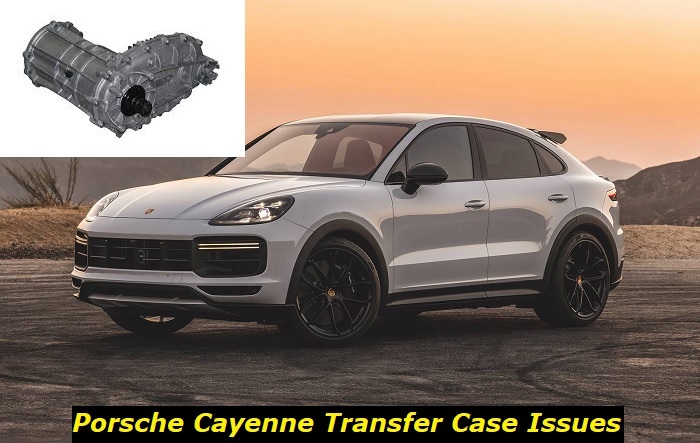Noticed your Porsche Cayenne has been experiencing rough and jerky acceleration? This issue and related ones like hearing a loud noise from the back of your car when driving are often tied to the vehicle's transfer case. Problems with Cayenne's transfer case are a known manufacturer's issue, so tend to be common.
Transfer case failures can be a dangerous situation because aside from the risk of being stranded, imagine what sudden jerks on the highway could lead to. But no one wants to have their luxury vehicle parked in their driveway for fear of the potential harm that may arise when driving.
You'll be glad to know that a problem with your Porsche Cayenne's Transfer Case doesn't mean your vehicle is damaged forever. We'll take you through a few potential solutions to the problem so you can determine whether or not it's something you are willing to go through.

What the Porsche Cayenne Transfer Case Does
One important component that helps to deliver the impressive performance of the Porsche Cayenne is the transfer case. But what exactly does the transfer case do?
Simply put, it distributes power from the engine to the wheels. The transfer case does this by transferring power from the transmission to the front and rear axles, depending on the driving conditions and the driver's needs.
It is an essential component of the four-wheel drive system found in many SUVs that allows the vehicle to distribute power evenly to all four wheels, helping to improve traction and stability in a variety of driving conditions.
In the Porsche Cayenne, the transfer case is controlled by the driver using a dial on the dashboard. This allows the driver to choose between different driving modes, including a full-time four-wheel drive mode, a rear-wheel drive mode, and a low-range four-wheel drive mode for off-road driving.
We will discuss some of the common causes of a bad Porsche Cayenne transfer case and how to diagnose and fix these problems.
Porsche Cayenne Transfer case Problems
Since the transfer case is essential for transferring power from the engine to the wheels, a malfunction can significantly impact the performance of your vehicle.
So, what could cause a bad Porsche Cayenne transfer case? Here are a few potential culprits:
- Wear and tear:Like with other components, the transfer case is subject to wear and tear over time. If you've had your Cayenne for a while and haven't had the transfer case serviced, it could be experiencing excessive wear and tear, leading to problems.
- Oil leaks:The transfer case relies on oil to function smoothly and efficiently. If there are leaks in the system, the oil level may drop, causing the transfer case to malfunction.
- Damage from off-road driving:While the Porsche Cayenne is a versatile vehicle, it's not designed for extreme off-road conditions. If you've taken your Cayenne on rough terrain, the transfer case may have sustained damage.
- Manufacturing defects:In some cases, the transfer case may fail due to a manufacturing defect. If this is the case, the issue should be covered under warranty.
Symptoms of a Bad Porsche Cayenne Transfer Case
With its tough engine and gearboxes that never seem to fail, the Porsche Cayenne is powerful enough to handle a variety of driving conditions. But it can develop problems over time due to any of the conditions mentioned above.
Here are some symptoms to watch out for that may indicate a problem with your Cayenne's transfer case:
1) Strange noises coming from underneath the vehicle
A bad transfer case can cause strange noises to come from underneath the vehicle, such as grinding, whirring, or clunking. These noises may occur when you shift gears, accelerate, or decelerate. If you hear any of these noises, have your transfer case checked by a mechanic as soon as possible.
2) Difficulty shifting gears
If you're having difficulty shifting gears, it could be a sign that your transfer case is failing. This issue can cause the gears to feel stiff or not engage properly, which can be frustrating and potentially dangerous while driving.
3) Inability to shift into four-wheel drive
You may notice that you can't shift into a four-wheel drive even when the conditions warrant it. This problem could be due to a faulty transfer case, which is responsible for transferring power to all four wheels.
4) Leaks underneath the vehicle
A leaking transfer case can cause oil to drip from underneath the vehicle. If you notice any oil spots on your driveway or garage floor, have your Cayenne checked for a leak.
5) Reduced fuel efficiency
A bad transfer case can also affect your vehicle's fuel efficiency. Getting less mileage per tank of gas than usual? It could be due to a faulty transfer case that's causing your engine to work harder than it should.
Porsche Cayenne Transfer Case Repair
One of the most frustrating aspects of transfer case issues in the Porsche Cayenne is the difficulty in repairing them. The transfer case is one of the vehicle's complex and intricate components, and repairing it requires specialized knowledge and experience.
Repairing a faulty transfer case can also be expensive. It will vary greatly depending on the extent of the damage and the specific parts that need to be replaced. If you suspect that your Cayenne's transfer case needs repair, there are a few steps you can take:
- Replace the Transfer Case
One of the most obvious solutions to a bad transfer case is to simply replace it. While this may be the most costly option, it is also the most effective. You can purchase a new or rebuilt transfer case from a reputable dealership or online seller. Just be sure to research the seller and get a high-quality part.
- Repair the Transfer Case
If your transfer case is not completely broken, it may be possible to repair it instead of replacing it. This option is typically more affordable than a full replacement, but it may not be as effective in the long run. It's best to consult with a mechanic or dealership to determine if repair is a viable option for your specific situation.
- Rebuilding the transfer case
If you're handy with car repairs, you may be able to rebuild the transfer case yourself using a rebuild kit. These kits typically include all the necessary parts and instructions to help you get the job done.
- Changing the fluid
It's also worth checking the fluid level and condition. If the fluid is low or dirty, it could be causing problems with the transfer case. Changing the fluid can help improve the performance of the transfer case and may solve your issues.
Replacing a Faulty Porsche Cayenne Transfer Case
This is often the most-preferred route Porsche Cayenne owners eventually take to fix a failing transfer case. Here are the steps involved:
- Gather the necessary tools and parts:You'll need a variety of sockets, wrenches, and other hand tools, as well as a replacement transfer case and any other necessary parts, such as seals and gaskets.
- Remove the damaged transfer case:Depending on the specific model of your Cayenne, the transfer case may be located in different areas of the vehicle. Refer to your workshop manual to locate the transfer case and remove it. You'll likely need to disconnect a variety of connectors and remove bolts to loosen and remove the transfer case.
- Clean the area around the transfer case:Use a clean rag to wipe away any dirt or debris from the area around the transfer case. This will help ensure a tidy, smooth installation of the new transfer case.
- Install the new transfer case: Carefully place the new transfer case in the designated area, making sure it is properly aligned. Use the bolts and connectors that you removed from the damaged transfer case to secure the new transfer case in place.
- Test the new transfer case: Once you have the new transfer case installed, it's important to test it to make sure it's functioning properly. Start the engine and shift the vehicle into a four-wheel drive to ensure that the transfer case is engaging correctly.
- Double-check all connections:Before driving the vehicle, double-check all of the connections to ensure that everything is tightened properly and that no bolts or connectors have been left loose.
Conclusion
When experiencing Porsche Cayenne transfer case symptoms, properly diagnose the issue and gather all necessary parts before beginning the repair process. While it may seem intimidating, tackling the repair yourself can save you a significant amount of money compared to taking it to a mechanic.
Remember to always follow the manufacturer's instructions and take necessary precautions to ensure your safety and that of your vehicle. With some patience and attention to detail, you can have your Cayenne back on the road in no time.
About the authors
The CarAraC research team is composed of seasoned auto mechanics and automotive industry professionals, including individuals with advanced degrees and certifications in their field. Our team members boast prestigious credentials, reflecting their extensive knowledge and skills. These qualifications include: IMI: Institute of the Motor Industry, ASE-Certified Master Automobile Technicians; Coventry University, Graduate of MA in Automotive Journalism; Politecnico di Torino, Italy, MS Automotive Engineering; Ss. Cyril and Methodius University in Skopje, Mechanical University in Skopje; TOC Automotive College; DHA Suffa University, Department of Mechanical Engineering






Add comment